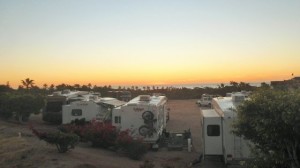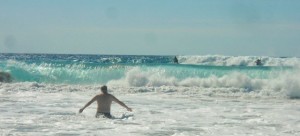
December 1, 2014 – Well we arrived today in La Paz and have set up at Campestra Maranatha, a campground just north of La Paz in El Centenario. Our visit to Todos Santos earlier today is always a favourite as many always look forward to the Hotel California experience. They have a wonderful Cultural Centre, Mission, Saints Alley and so many interesting shops. Lisa and I enjoyed our brunch, some headed over to George’s Taco Stand others at Cafelix. It was only a short drive today from Pescadero where we stayed at the Los Cerritos Surf Colony RV Park the night before. Although this is called an RV Park it is not much more than a parking lot with access to other amenities. Unfortunately the place sustained heavy damage from Odile and was just commencing operation with the official opening tomorrow. The swim up bar and restaurant remained in renovation and should be ready in a couple of weeks. When we showed up they were just filling pool and only 2 tourists other than us were present. Teresa from Oregon office was supervising the opening and getting the operation up and going. We did manage to get in the pool and of course on the beach. At 5pm we headed for La Pasadita in Pescadero for our hosted dinner. Jose always does a great job and after for those interested we watched the Grey Cup game played in Vancouver at BC Place Stadium. It was an exciting game at the end and came down to a final play.

As our time in Los Cabos was extended we had time to join our friends Rick & Ronnie for dinner at Lattitude 22, home of No Bad Days (well maybe one Chabasco Odile), we also went for dinner with Peter & Geraldine who live at Cabo Bello. We had the usual excursions, Playa Santa Maria, San Jose Art District and I met Frank Arnold and partner Carmen who have a Gallery in San Jose del Cabo. Many of the gang were out and about, Chris went diving and organized a boat ride to the Arch, Lover’s & Divorce beach. Peter and I headed out into the mountains on Peter’s Razor (Side X Side). This adventure included the community of Candelaria you would not believe how much water there was in the arroyo. Our Playa Medano Happy Hour was a great success as always, we sure had fun.


Tomorrow we have an excursion planned into La Paz, the tour continues, fun and adventure!

Did you know?
Diego Rivera was born on December 8, 1886, in Guanajuato, Mexico and when his career began, the main focal point behind his works was to depict the lives of Mexico and its people. In 1921, working with the government, he began work on a series of murals, that were located in public buildings. Some of his work was quite controversial; in fact, the Man at the Crossroads, which featured a portrait of Vladmir Lenin, which went up in NYC at the RCA building, was destroyed by the Rockefeller Family. He is today known as one of the greatest artists of the 20th century, and began working and drawing at the age of 10. His passion for art emerged early on. He began drawing as a child. Around the age of 10, Rivera went to study art at the San Carlos Academy of Fine Arts in Mexico City. One of his early influences was artist José Posada who ran a print shop near Rivera’s school and furthered his education in Europe in 1907; while in Europe, he became friends with several famous artists, including Pablo Picasso, Marc Chagall, and Piet Mondrian.

Famous Muralist
Diego Rivera had some success as a Cubist painter in Europe, but the course of world events would strongly change the style and subject of his work. Inspired by the political ideals of the Mexican Revolution (1914-15) and the Russian Revolution (1917), Rivera wanted to make art that reflected the lives of the working class and native peoples of Mexico. He developed an interest in making murals during a trip to Italy, finding inspiration in the Renaissance frescos there. Returning to Mexico, Rivera began to express his artistic ideas about Mexico. He received funding from the government to create a series of murals about the country’s people and its history on the walls of public buildings. In 1922, Rivera completed the first of the murals at the Escuela Nacional Preparatoria in Mexico City.

Due to the controversial nature of this, as well as the other works which Diego Rivera created during this illustrious career, he became known as one of the leading artists in the 20th century. Not only in the US, where much of his work was debated, and even destroyed, but around the world. Since he took a worldly view on art, and depicted controversial scenes which depicted different forms of politics, which were not established around the world, many of his art pieces were quite unique, and were distinct in nature from the work which other muralists had done. And, the fact that he shared an interest in certain political views, which were not widely accepted around the world, also made for a unique twist on the art he created, and a distinct style with the creation and work that he did while creating the murals which he painted during the course of his career.

Commercial Success
In the 1930s and ’40s, Diego Rivera painted several murals in the United States. As mentioned earlier some of his works created controversy, especially the one he did for the Rockefeller family in the RCA building in New York City. The mural, known as “Man at the Crossroads,” featured a portrait of Russian Communist leader Vladimir Lenin. The artist had reportedly included Lenin in his piece to portray the turbulent political atmosphere at the time, which was largely defined by conflicting capitalist and socialist ideologies and escalating fears surrounding the Communist Party. The Rockefellers disliked Rivera’s insertion of Lenin and, thusly, asked Rivera to remove the portrait, but the painter refused. The Rockefellers then had Rivera stop work on the mural.

In 1934, Nelson Rockefeller famously ordered the demolition of “Man at the Crossroads.” Publish backlash against the Rockefellers ensued; after long proclaiming a deep dedication to the arts, the powerful family now looked both hypocritical and tyrannical. John D. Rockefeller Jr. later attempted to explain the destruction of the mural, stating, “The picture was obscene and, in the judgment of Rockefeller Center, an offense to good taste. It was for this reason primarily that Rockefeller Center decided to destroy it.”

Later Life and Work
In the late 1930s, Rivera went through a slow period, in terms of work. He had no major mural commissions around this time so he devoted himself to painting other works. While they always had a stormy relationship, Rivera and Kahlo decided to divorce in 1939. But the pair reunited the following year and remarried. The couple hosted Communist exile Leon Trotsky at their home during this period. Rivera returned to murals with one made for the 1940 Golden Gate International Exposition held in San Francisco. In Mexico City, he spent from 1945 to 1951 working on a series of murals known as “From the Pre-Hispanic Civilization to the Conquest.” His last mural was called “Popular History of Mexico.”

Personal Life and Death
Diego had a twin brother named Carlos, who died two years after they were born. His mother was a Converso, whose ancestors were forced to convert from Judaism to Catholicism. Speaking about himself, Rivera wrote in 1935: “My Jewishness is the dominant element in my life.” Rivera began drawing at the age of three, a year after his twin brother’s death. He had been caught drawing on the walls. His parents, rather than punishing him, installed chalkboards and canvas on the walls. As an adult, he married Angelina Beloff in 1911, and she gave birth to a son, Diego (1916–1918). Maria Vorobieff-Stebelska gave birth to a daughter named Marika in 1918 or 1919 when Rivera was married to Angelina (according to House on the Bridge: Ten Turbulent Years with Diego Rivera and Angelina’s memoirs called Memorias). He married his second wife, Guadalupe Marín, in June 1922, with whom he had two daughters: Ruth and Guadalupe. He was still married when he met art student Frida Kahlo. Rivera and Kahlo shared an interest in radical politics and Marxism. They married on August 21, 1929 when he was 42 and she was 22. Diego Rivera lost his wife, Frida Kahlo, in 1954. The following year, He married Emma Hurtado, his art dealer. By this time, Rivera’s health was in decline and traveled abroad for cancer treatment, but doctors were unable to cure him. Diego Rivera died of heart failure on November 24, 1957, in Mexico City, Mexico. Since his death, Diego Rivera is remembered as an important figure in 20th century art. His childhood home is now a museum in Mexico. His life and relationship with Frida Kahlo has been remained a subject of great fascination and speculation. On the big screen, actor Ruben Blades portrayed Rivera in the 1999 movie Cradle Will Rock. Alfred Molina later brought Rivera to life, co-starring with Salma Hayek in the 2002 acclaimed biographical film Frida.

Whether or not you agree with his political stand points, or the relationships he engaged in during his lifetime, the creative manner and approach, and the disregard for what people thought about his art, makes Diego Rivera one of the most famous, and most renowned artists which existed during this time period. Rivera’s philosophy of art and life correspond to no specific dogma. But instead had an extraordinarily well developed intuitive sense that shaped his understanding of the world and his humanistic understanding of the role of the artist and the role of art in society. His ability to masterfully present universal images and ideas in his art continues to captivate the viewer’s today.

Some of Rivera’s most famous murals are featured at the National School of Agriculture at Chapingo near Texcoco (1925–27), in the Cortés Palace in Cuernavaca (1929–30), and the National Palace in Mexico City (1929–30, 1935).



